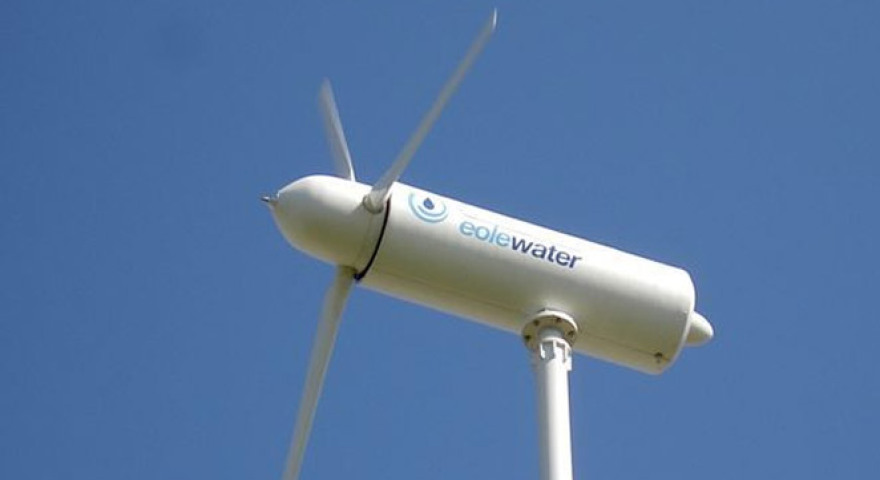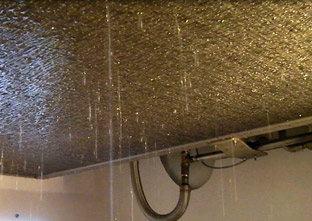Making water from air

You have succeeded in developing a new type of wind turbine capable of producing water. How and why is it so innovative ?
It is true that a quick glance at our wind turbines isn't enough to guess the technology that lies beneath the nacelle. Using wind turbines to pump water isn't a new idea. The Dutch used to regulate the water-level in the polders through windmills that acted as water pumps. In the same vein, the small wind turbines that you always see in movies set in the Old West are also used to power water pumps. Our wind turbine is nothing like that, rather than pumping water, it uses the simple principle of air condensation to produce safe drinking water.

How did this idea come around ?
 Marc Parent, the founder of the company and the inventor of the system, lived in the Caribbean in the 1990s. As he was emptying out the water accumulated in his air-conditioning system, he wondered whether it might be possible to design an autonomous machine capable of producing water through this same process. The idea of a wind turbine sucking in air and transforming it into water was almost a no-brainer. In the early 2000s, few people believed in the project. It happened anyway. And of course, the idea has since been picked up by others. While we invented the technology, we are no longer alone on this very promising market. As precursors, we're still able to keep ahead of the competition and we have that extra bit of know-how.
Marc Parent, the founder of the company and the inventor of the system, lived in the Caribbean in the 1990s. As he was emptying out the water accumulated in his air-conditioning system, he wondered whether it might be possible to design an autonomous machine capable of producing water through this same process. The idea of a wind turbine sucking in air and transforming it into water was almost a no-brainer. In the early 2000s, few people believed in the project. It happened anyway. And of course, the idea has since been picked up by others. While we invented the technology, we are no longer alone on this very promising market. As precursors, we're still able to keep ahead of the competition and we have that extra bit of know-how.
How does it work ?
 As you know, the air around us is more or less saturated with water vapour. Broadly speaking, the wind turbine provides the energy to power a turbine which sucks in the air. Once it has been drawn into the system, the air is cooled by a condenser which converts water vapour into its liquid state. The water is collected in a fibreglass / epoxy tray, flows down the central pipe and then passes through a filtration system converting it into safe drinking water. It sounds simple enough on paper, but we had to go through several prototypes before achieving a satisfactory result because we had to pack the whole water creation system into the nacelle - the body of the wind turbine. It wasn't an easy task considering the condenser alone weighs over a ton. So we had to come up with many technical solutions to avoid overloading the nacelle.
As you know, the air around us is more or less saturated with water vapour. Broadly speaking, the wind turbine provides the energy to power a turbine which sucks in the air. Once it has been drawn into the system, the air is cooled by a condenser which converts water vapour into its liquid state. The water is collected in a fibreglass / epoxy tray, flows down the central pipe and then passes through a filtration system converting it into safe drinking water. It sounds simple enough on paper, but we had to go through several prototypes before achieving a satisfactory result because we had to pack the whole water creation system into the nacelle - the body of the wind turbine. It wasn't an easy task considering the condenser alone weighs over a ton. So we had to come up with many technical solutions to avoid overloading the nacelle.
Can you tell us any more ?
Of course, but first of all, I'd like to talk about our wind turbine's features. We are currently able to produce about 1000 litres of drinking water per day with an average humidity of 45% and an average temperature of 24°. It also generates 30 kilowatts of power. In the early 2000s, our smaller and simpler prototypes could "only" produce around 50 litres...

Coming back to the condenser - how did you solve the problem ?
 There are plastic condensers on the market, but for the time being we have chosen to go with stainless steel condensers. However, we haven't yet discounted plastic condensers and they could feature in our next wind turbines. We are still studying the possibility at this time, even though we are well aware of the fact that plastic is easily mouldable and, more importantly, is much lighter than metal. Furthermore, it requires very little maintenance as it does not degrade over time and is resistant to all weather conditions. We took the same approach for all the filters. Thanks to the different polymers they’re composed of , they are easily removable and washable or replaceable at low cost. This is the most important consideration for our customers, and it serves as a guarantee that they will always have access to clean drinking water.
There are plastic condensers on the market, but for the time being we have chosen to go with stainless steel condensers. However, we haven't yet discounted plastic condensers and they could feature in our next wind turbines. We are still studying the possibility at this time, even though we are well aware of the fact that plastic is easily mouldable and, more importantly, is much lighter than metal. Furthermore, it requires very little maintenance as it does not degrade over time and is resistant to all weather conditions. We took the same approach for all the filters. Thanks to the different polymers they’re composed of , they are easily removable and washable or replaceable at low cost. This is the most important consideration for our customers, and it serves as a guarantee that they will always have access to clean drinking water.
When can we expect to see it on the market ?
 The tests have been very successful and we have already begun marketing the product. We installed our latest prototype in Dubai, in the Persian Gulf. It may seem like an odd choice, but we chose one of the driest places on the planet to demonstrate how our technology works. Weather conditions in Dubai are extreme: aridity, the presence of sea salt in the air, pollution...It was a bold choice, but we stand by it as we have been able to produce hundreds of litres of water daily. This should be more than enough to convince investors and potential customers!
The tests have been very successful and we have already begun marketing the product. We installed our latest prototype in Dubai, in the Persian Gulf. It may seem like an odd choice, but we chose one of the driest places on the planet to demonstrate how our technology works. Weather conditions in Dubai are extreme: aridity, the presence of sea salt in the air, pollution...It was a bold choice, but we stand by it as we have been able to produce hundreds of litres of water daily. This should be more than enough to convince investors and potential customers!
After having drained the groundwater tables, is there not a risk of drying up the air ?
Absolutely not. Unlike groundwater tables, the moisture in the air gets renewed very quickly. When the device sucks in the ambient air, it takes between 4 and 24 hours for it to regain its initial moisture level. I should like to add that we only "extract" around 50% of the water present in the air and that, contrary to what I've read, we do not vacuum up clouds.

When will your wind turbine be available to buy ?
 We have already started marketing our product. The tests carried out in Dubai have been particularly successful. As is the case with any industrial product, particularly when it is innovative, daily improvements are made to the design, and especially to the electronic part of the system. Our engineers are making rapid progress. Thanks to plastics (although they are not the only materials that we use), we should be perfectly capable of effectively isolating all the electronic components, much like cables sheathed in PVC for the same reasons. Our processes have been finalized and we'll be able to begin mass production shortly.
We have already started marketing our product. The tests carried out in Dubai have been particularly successful. As is the case with any industrial product, particularly when it is innovative, daily improvements are made to the design, and especially to the electronic part of the system. Our engineers are making rapid progress. Thanks to plastics (although they are not the only materials that we use), we should be perfectly capable of effectively isolating all the electronic components, much like cables sheathed in PVC for the same reasons. Our processes have been finalized and we'll be able to begin mass production shortly.
 This is thanks in no small part to the versatility of fibreglass, which we use for many parts except for certain specific ones, as it does not require highly complex machinery to mould it into the required shapes.
This is thanks in no small part to the versatility of fibreglass, which we use for many parts except for certain specific ones, as it does not require highly complex machinery to mould it into the required shapes.
The moulding of the fibre/resin composite offers a better value for money than pressing sheet-metal. This enables us to offer a wind turbine at a relatively affordable price. Let us not forget that they are intended, for the most part, for the poorest and particularly to the most remote villages facing difficulties in gaining access to drinking water.
MORE INFORMATION





